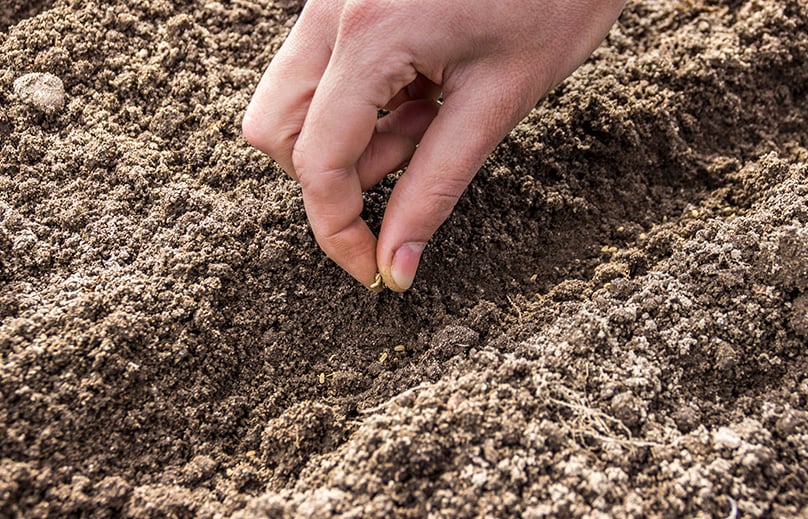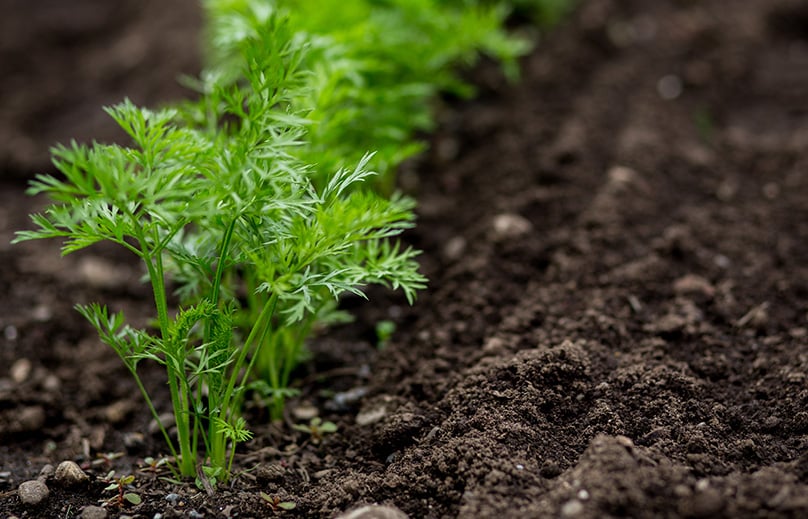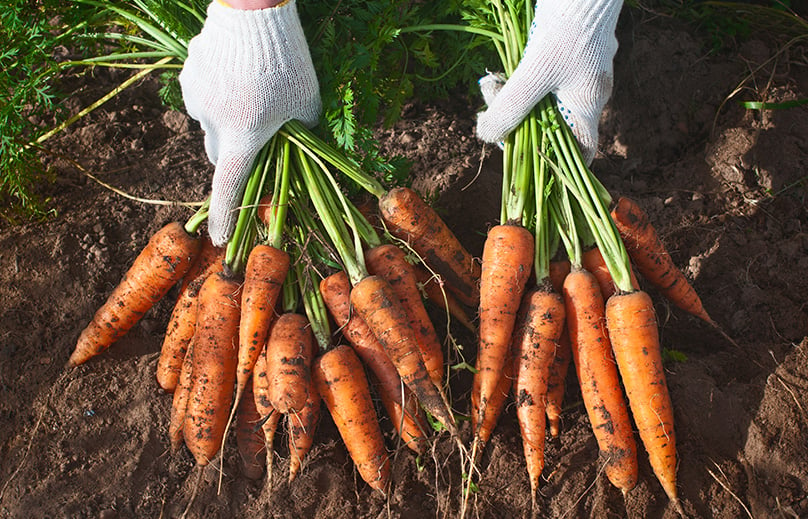Did your mom tell you that carrots are good for your eyesight? She wasn’t’ kidding around.
Carrots are a rich source of vitamins and minerals. These root veggies are high in a polyphenol compound known as “beta-carotene.” Beta-carotene gives carrots their natural orange color, and it promotes retina health in your eyes.
That’s one more reason why you should consider growing carrots in your vegetable garden this summer. Organic carrots grown in your vegetable garden taste sweeter and have a better texture than carrots you get from the store. By using organic nutrients in your veggie patch, you’ll produce the best-tasting carrots you ever have the pleasure of eating.
However, one of the most common complaints from organic gardeners regarding their carrot crop is that the carrots don’t grow straight. Fortunately, there are planting methods that help you avoid this happening to your carrot crop.
You can grow these root vegetables in many different climates, and they thrive with little maintenance and fertilizer needed during the growing season. Carrots do prefer the cooler ends of the growing season, making them an ideal vegetable to plant early in the season.
It may surprise you to learn that not all carrots are orange! You also get white, red, and purple varieties as well. This growing guide for carrots gives you everything you need to know about planting this root vegetable in your garden this season.
Recommended Carrot Varieties
There are a variety of carrots to choose from when planting your crop. Our favorite carrots to cultivate include the following types;
- “Nantes” – This variety grows to lengths of 6 to 7-inches, and they have a cylindrical, not tapered, appearance.
- “Danvers” – This variety are a classic-style carrot, growing to lengths of 6 to 8-inches. These carrots have your typical dark-orange color and a sweet taste.
- “The little finger” – This is one of the more popular dwarf carrot varieties.
- “Bolero” – This variety is resistant to disease and pests, making it an excellent choice for the novice gardener.
Planting Your Carrots
It’s best to plant your seeds outdoors around four to five weeks before the last frost date.
You can extend your harvest by planting additional crops every three weeks until the mid-summer.
- Carrot seeds garden seeds vegetable seeds bulk
- 100% ORGANIC AND NON-GMO: There's no need to worry about intoxicants that may hinder your plant's growth because Back to the Roots Seeds are completely organic and not genetically modified
- ZERO-RISK GARDENING: Made in the USA and 100% guaranteed to grow; No green thumb. No problem If you're having trouble with our organic seed pack, we'll send you as many seeds as you need to get growing
- True to size
- Premium, Non-GMO, Heirloom Seeds
- High Germination Rates
- Packaged for the Current Growing Season
- Tendersweet Carrot Seeds
- Plant Two Crops - Spring & Summer - For a Longer Harvest
Last update on 2024-09-27 / Affiliate links / Images from Amazon Product Advertising API
We recommend that you plant your carrots in direct sunlight for best results and the highest yield from your crop. Carrots that grow in the shade won’t grow as large as those in the sun, and they may also turn to a woody texture in the late days before harvest.
Place garden fleece on the soil around your carrots during the peak of the summertime. This strategy helps to keep the ground cool during peak sun hours of the day. If the soil gets too warm, it may stunt the growth of your carrot crop.

Preparing Your Soil for Planting
Before you plant your carrot seeds in the ground, we recommend that you take some time to prepare the soil for planting. Soil conditions are one of the key factors for growing large, juicy carrots in your garden. Make sure that you till the soil to a depth of at least 18 to 24-inches before you start planting.
- Do this tilling work three weeks before you put the seeds in the ground. Remove all of the stones and soil clots from the ground, as this is often one of the reasons why carrots don’t grow straight. If the carrot has to deal with a stone in the way, it will grow around the obstruction, resulting in bent carrots.
- After tilling, we recommend that you fertilize the soil using organic materials like compost and mulch. Work it into the ground in your flowerbed, and then let the soil rest for three weeks before planting your seeds.
Carrots don’t mind growing in slightly colder conditions, so there’s no need to start your seeds indoors. Carrots enjoy growing in loose, loamy soil that allows them to push down into the ground easily. We recommend that you avoid adding commercial fertilizers to your soil, and stick with organic materials, carrots don’t need lots of nutrients to thrive.
It’s also important to avoid using fresh manure when fertilizing your carrots. Fresh manure will cause the carrots to split and fork, resulting in deformations to the typical straight structure of the root vegetable.
In some cases, you may pull up your carrots to find they experienced stunted growth. Compacted soil will make it hard for carrots to extend down into the ground, resulting in stunted growth in your carrot crop. It’s for this reason that tilling your soil before planting is so important when growing carrots.

Avoid adding nutrients like nitrogen to the soil. Additional nitrogen makes the carrots grow long and thin, and they will taste woody after harvesting. We also recommend that you plant your seeds directly into the ground, rather than starting seedlings. Space your seedlings 4-inches apart, in rows that are 12-inches apart.
Remember to keep the soil moist using waterings every day during germination. After the carrots establish themselves, you can switch to watering every other day in warm climates, or every three days in colder regions of the United States.
Make sure the soil does not crust over after watering and dig around the carrots to improve aeration in the ground. The more air your carrots get, the bigger the harvest. Even if you take all the precautions listed in this article when planting your carrots, they may still bend while growing.
You can’t expect organic crops to be perfect in size and structure. It should, however, give you pause for thought as to why most commercial crops don’t have this problem.
Check the soil moisture by pressing your finger a few inches into the ground. If it feels wet, then you don’t need to water, and if it’s dry, give your carrots a drink. Carrots germinate slowly, and it might be two to three weeks before you start to see the tops begin to poke out of the soil.
Taking Care of Your Crop
After finishing planting your carrot crop, it’s time to mulch around the flowerbed to bring more nutrients into the soil and reduce evaporation from the ground. Mulch also provides a layer of insulation that keeps the ground cooler than other areas of your vegetable garden.
It’s essential to weed your vegetable garden at least two to three times a week, especially when the carrots are starting. Depending on growing conditions in your climate, it makes take your carrot crop anywhere between two to four months to reach maturity.
We recommend that you avoid leaving carrots in the ground for too long, as it results in a woody texture and loss of flavor in your carrot crop.

Pests and Diseases Affecting Your Carrots
While the majority of your carrot spends its day’s underground, it’s still at risk of pests destroying the tops of the root vegetables. The most common pests found in carrot crops include flea beetles and wireworms that burrow into the carrots foliage, causing bumps in the leaves.
Place the leaves between your fingers and run them up to the top. If you notice any bumps forming in the leaves, press them between your fingers to crush the bugs.
Fungal disease infecting carrot crops can stunt their growth and leave you with underdeveloped crops. The most common disease affecting the growth and health of your carrots include Aster yellow disease, which discolors your carrots and causes the growth of hairy roots. Pests spread this disease as they feed on your crop.
Harvesting Your Carrots
As mentioned, your carrots will take anywhere between two to four months to reach maturity. The growing season depends on climate conditions and rain, and if you live in a warm, rainy climate, you can expect your carrots to finish sooner than in colder conditions.
If you want an accurate measure on when your carrots are ready for harvest, wait until the tops are around a half an inch in diameter before pulling. This strategy also depends on the variety of carrot you are growing, and smaller types may require pulling sooner.
When harvesting, remember to pull your plants in the early morning before the sun gets too high and the ground starts to heat up. Pulling your carrots in hot weather may cause the root vegetables to turn fibrous and develop a woody taste.
We recommend you leave harvesting your final carrot crop until after the first frost. Frost seems to make your carrots taste sweeter, and they’ll last longer in storage as well. Cover your crop with hay while you wait for the first frosts of the season.

Storing Your Carrots
After harvesting your carrots, take them inside and twist off the tops. Scrub them clean and pat them dry. Send the carrots to your root cellar, bury them in the sand, and store them in the dark under cool temperatures.
You can also store your carrots in the fridge, but make sure you let them rest for a few hours after topping and cleaning, or they’ll go limp in the crisper drawer.



